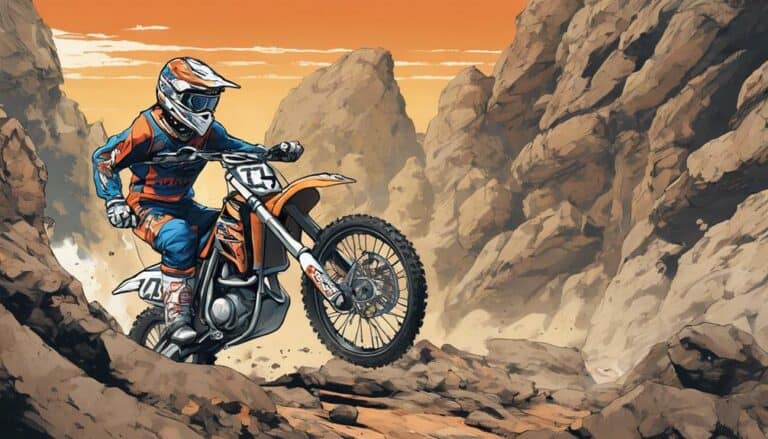When conquering an Enduro course, there's more than meets the eye when it comes to how pro dirt bike riders determine their speed. It's not just about twisting the throttle and hoping for the best. Understanding the intricate dance between pushing limits and exercising caution is key to their success.
But have you ever wondered how they actually make these split-second decisions on the track? Let's uncover the intricate strategies and techniques behind their speed management in the exhilarating world of Enduro racing.
Key Takeaways
- Pro riders adjust speed based on terrain analysis and obstacle evaluation.
- Mastery of speed control techniques helps in navigating varying terrains efficiently.
- Race strategy involves timing for overtaking and precision in slow sections.
- Body positioning is crucial for speed management, signaling acceleration or deceleration.
Reading the Terrain and Obstacles
Pro Dirt Bike Riders meticulously analyze the terrain and obstacles ahead to make split-second speed adjustments for peak performance. By evaluating terrain features such as rocks, roots, and ruts, riders can anticipate how these elements will affect their speed and maneuverability. Understanding the trail's incline, camber, and surface conditions is vital in determining the appropriate speed adjustments needed to navigate through obstacles efficiently.
Obstacles play a significant role in dictating speed changes during a race. Pro riders read the obstacles ahead to anticipate the level of challenge they pose and adjust their speed accordingly. Whether it's a sharp turn, a series of jumps, or a technical section, being able to assess these obstacles in advance allows riders to maintain control while pushing the limits of their speed.
Mastering Speed Control Techniques
Mastering speed control techniques in enduro racing requires a combination of skill, experience, and precise throttle modulation. To excel in this aspect, pro riders focus on specific areas:
- Front End Awareness: Understanding how your bike's front end reacts to throttle inputs is crucial. By mastering this, you can better navigate tight turns, steep descents, and technical sections with precision.
- Throttle Control: Being able to modulate the throttle smoothly is key to managing speed effectively. Pro riders finely tune their throttle inputs to match the terrain, ensuring optimal traction and acceleration.
- Adaptability: Enduro races present varying terrain and obstacles, requiring quick adjustments in speed. Pro riders develop the ability to adapt their speed control techniques on the fly, optimizing performance throughout the race.
- Consistent Practice: Regular practice sessions allow riders to hone their speed control skills. By repetition and refinement, pro riders build muscle memory and intuition, enhancing their overall speed management capabilities.
Understanding Race Strategy and Timing
Analyzing race dynamics and timing in enduro competitions plays a pivotal role in a pro rider's strategic approach to optimizing performance. Understanding the race strategy involves evaluating terrain difficulty and energy conservation needs to determine the appropriate speed.
Pro riders strategically choose when to push for speed based on the course sections and competition. Timing fast sections for overtaking and slow sections for technical precision is critical in gaining an edge over competitors. Monitoring competitors' pace and adjusting speed accordingly is part of the race strategy to stay competitive.
Additionally, pro riders need to have a clear understanding of their own endurance limits to pace themselves effectively throughout the race. By strategically balancing speed and precision based on the terrain difficulty, pro riders can enhance their chances of success on the challenging enduro tracks.
Utilizing Body Positioning for Speed Management
Optimizing speed and control in enduro races hinges considerably on the precise adjustment of body positioning by expert riders. To manage speed effectively, pro dirt bike riders utilize body positioning techniques that signal the need for either acceleration or deceleration. Here's how they do it:
- Leaning Forward: By leaning forward and gripping the bike tightly, riders signal to their bodies to shift weight towards the front wheel. This posture encourages speed and forward momentum.
- Shifting Weight Backward: Conversely, shifting weight backward and using brakes shifts the focus towards the rear wheel, signaling the need to slow down. This adjustment helps in controlling speed and maintaining stability on challenging terrain.
- Traversing Terrain: Expert riders instinctively adjust their body positioning to traverse varying terrain effectively. This adaptability allows them to tackle obstacles with precision and speed.
- Optimizing Speed and Stability: By mastering body positioning techniques, riders can optimize both speed and stability throughout the race, ensuring a competitive edge in enduro competitions.
Implementing Braking and Acceleration Strategies
When executing enduro races, pro dirt bike riders strategically incorporate braking and acceleration techniques to navigate various terrains effectively. Braking techniques play a vital role in controlling speed, especially in challenging sections where precision is paramount. By modulating the brakes, riders can smoothly navigate steep descents, tight corners, and obstacles with finesse. On the other hand, acceleration becomes instrumental in open sections or when powering through obstacles that require momentum. Pro riders adeptly balance braking and acceleration based on traction levels, upcoming obstacles, and trail conditions to maintain a prime pace throughout the race.
Mastering these techniques allows riders to swiftly adapt to changing terrains, ensuring they can tackle each section with confidence and control. By strategically implementing braking and acceleration strategies, pro dirt bike riders can harness the full potential of their bikes, showcasing a blend of speed and precision that sets them apart in the competitive world of enduro racing.
Conclusion
You've mastered the art of traversing the treacherous terrain, balancing on the edge of control like a tightrope walker in a storm. Your split-second decisions and calculated risks have propelled you to victory, weaving through obstacles with the precision of a surgeon wielding a scalpel.
With each twist of the throttle and calculated brake tap, you dance with danger, pushing the limits of speed and skill in the thrilling world of Enduro racing.

